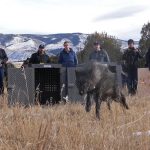Breeder’s Connection 2025 | Wagner Charolais
From Sheep to Chars: Wagner Charolais offers top tier genetics to the region
In a market dominated by black cattle, Colorado rancher Bob Wagner’s dare to be different has allowed him the unique opportunity to provide the region with high-quality Charolais genetics. Originally a sheep producer, Wagner raised Suffolk sheep for 10 years before he and his wife Jan moved to their current ranch which Wagner decided was not well suited to being a financially feasible sheep operation.
Forced to rethink his ranching plan without sheep, Wagner purchased a herd of older bred cows with the intention of selling them quickly after calving them out. However, he was blown away by the quality of the Charolais-sired calves in the bunch.
“What surprised me was how good they looked after calving,” Wagner recalled. He noticed Charolais-cross calves stood out for their distinct qualities, saying, “They were easy to pick out.”
This observation led him to seek out Charolais bulls, eventually forming a close working relationship with Charolais field representatives. That decision transformed his herd into an entirely Charolais operation, where he now manages over 200 cows.
“I’d been involved in the Suffolk sheep business before,” he said. “Both Suffolk sheep and Charolais are terminal sire livestock, so I decided to go from a commercial operation a to purebred operation.”
His wife even supported this transition by giving him his first Charolais cattle as a Christmas gift one year. Eventually, Wagner sold his commercial cows with the help of John Bauman and converted his entire herd to Charolais.
“The big value in Charolais is not in straight-Charolais herds, but instead in a system where you can cash in on the heterosis present with black or red cattle. In those systems, Charolais genetics can do what they do best – which is gain weight.”
– Bob Wagner
With the market favoring smaller framed, lower birth weight cattle, Charolais cattle can often struggle to compete with other breeds due to their historically larger frames. However, Wagner notes he has had no issues with larger calves on his cows and they perform well in the feedlot.
While the size of Charolais calves can make some ranchers nervous, Wagner notes he can count on one hand how many calves he has pulled in the last three years, with most of the issues caused by misplacement of the calf and not size.
“I had a 128-pound calf born recently and he got up straight away to nurse,” he says. “A lot of these lower birth weight calves struggle to catch up to their larger peers.
“I would rather have a bigger calf that is healthy than a smaller one with a lot of catching up to do,” Wagner says. “If you look at modern Charolais, there is a huge difference in the front end and head structure compared to their historic French ancestors, we have come a long way with front end structure and that helps a lot with calving issues.”
“I was very lucky to have bred a bull who was the number one bull in the breed for calving ease and top five for birth weight,” he explains. “We have built a herd with tremendous calving ease and I really do think that makes the biggest difference.”
Wagner notes Charolais are well-known for their rate of gain, muscling and feed efficiency, such that they offer benefits when crossbred with popular black or red breeds. “When breeding for hybrid vigor, the benefits Charolais cattle bring to the table for terminal crosses cannot be denied,” he says.
“The reality is Charolais have everything but marbling and we’re gaining on marbling at an impressive rate,” he said. “But when crossbred, they bring feed efficiency and growth, which is valuable to producers and packers alike.”
Wagner currently runs around 200 head of registered Charolais and will host his 14th annual bull sale Apr. 5, 2025.
Wagner recently invested in a new bull to bring fresh genetics into his herd. While he retains ⅔ ownership of this bull, Governor, Wagner agreed to a semen-only agreement due to the often-unforgiving nature of his ranch.
“It’s not always easy keeping these bulls alive in these conditions,” he explains. “I am AI’ing cows and will have at least 20 of his offspring in my upcoming spring sale.”
Wagner also places a lot of emphasis on docility and having a herd he can easily work with dogs.
“Charolais have a reputation for having nasty attitudes and I give ours one chance to act out before they get sent on the cull truck,” he says.
Along with Charolais cattle, Wagner also raises Border Collies, which are essential to his unique approach to ranching without horses.
“I have never been a horse person,” Wagner explained. “The dogs work very well in our conditions, going across draws that we can’t get across.”
Wagner’s dedication to working dogs extends beyond the ranch; he’s one of the founders of the National Cattle Dog Association and organizes the cattle dog trial at the Denver Stock Show.
Moving forward, Wagner hopes to continue to improve the quality of his herd and continue to offer quality Charolais genetics to commercial and seedstock operations alike.
“The big value in Charolais is not in straight-Charolais herds, but instead in a system where you can cash in on the heterosis present with black or red cattle. In those systems, Charolais genetics can do what they do best – which is gain weight.”












